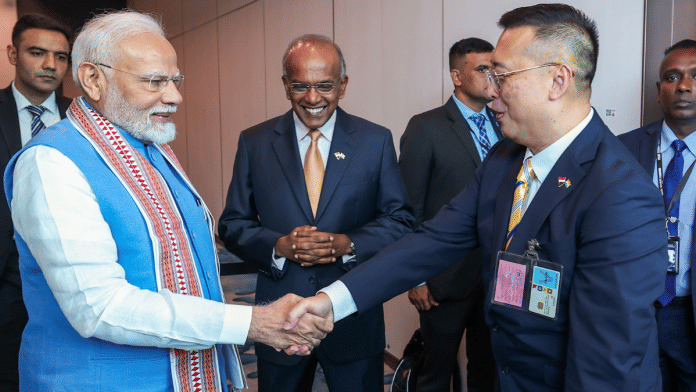New Delhi: Cooperation in the semiconductor field will be a key emphasis during Prime Minister Narendra Modi’s visit to Singapore, as India seeks to become part of the global manufacturing hub for the critical technology.
In terms of de-risking and improving supply chain resilience, Singapore is being seen as a safe bet in the era of US-China rivalry.
Interestingly, Singapore–despite being a small city-state–contributes to around 10 percent of global semiconductor output, 5 percent of global wafer fabrication capacity, and 20 percent of semiconductor equipment production.
According to Indian government sources, nine of the world’s 15 top semiconductor firms have set up shop in Singapore.
“In the 1960s, US chip makers, looking for lower labour costs with a sufficiently skilled workforce, started to offshore parts of their production process to Southeast Asia, including Singapore,” a source added
According to sources, the business environment in Singapore actively facilitates such investments as it creates well-paying jobs in the manufacturing sector in the otherwise service-dependent economy.
It states that Singapore’s infrastructure and connectivity, stable business conditions, a critical mass of leading companies covering the value chain–from design to wafer fabrication, to assembly and testing–and human capital have contributed to the rise of the industry.
To develop talent, Singapore universities are offering majors in microelectronics and integrated circuit design. They are also collaborating with semiconductor companies by encouraging their employees to pursue PhD research.
Also read: Deepening space & energy cooperation, talks on South China Sea: Takeaways from Modi’s Brunei visit
Challenges encountered by Singapore’s semiconductor sector
Singapore has managed to attract major investments in this sector since the Covid pandemic. In 2022, Taiwan’s United Microelectronics Corporation announced an investment of $5 billion to set up a semiconductor fabrication plant. It is expected to begin operations in 2024.
Last September, GlobalFoundries inaugurated its new $4 billion fabrication plant in Singapore. This plant is capable of manufacturing specialty chips through 28 nanometres (nm) node technology–most advanced in Singapore.
In June 2024, NXP Semiconductors and TSMC-backed Vanguard International Semiconductor Corp announced a $7.8 billion joint venture for a Singapore plant-VisionPower Semiconductor Manufacturing Company–that will make 40 to 130 nm chips for the automotive, industrial, consumer, and mobile market segments. Construction will commence in the second half of 2024, with production starting in 2027.
However, there are several challenges faced by Singapore’s semiconductor industry, sources said, elaborating that the city-state’s semiconductor industry is limited to “mature-node chips”–process node technology of 28 nm or more–which are used in appliances, cars, and industrial equipment.
It is not equipped to make high-end logic chips like the ones used in the artificial intelligence sector. AI chips have process nodes of 7 nm and smaller and thus require specialised production methods.
Moreover, the cost of production is increasing in Singapore, forcing the semiconductor companies to move up in the value chain and diversify low-cost/labour intensive operations out of the city-state.
For example, UTAC Group–a semiconductor test and assembly services provider–has moved some of its more manual and technologically dated operations to Thailand. UTAC’s Singapore focus has shifted towards research and development.
Sources said that Singapore offers opportunities for India, and their universities have developed customised courses for the semiconductor sector.
India is also keen on knowledge sharing about best practices of managing semiconductor industrial parks called–Wafer Fab Parks in Singapore.
Sources explained that in terms of production factors, Singapore has limitations for land and labour.
“India, with abundant land and skilled labour, can be part of Singapore’s semiconductor value chain. Semiconductor companies in Singapore can be encouraged to consider India for their expansion plans,” a source said.
What is also of significance to India is that Singapore has semiconductor equipment and material manufacturers. For development of the semiconductor manufacturing ecosystem in India, engagement and collaboration with such companies may also be helpful, sources said.
(Edited by Tarannum Khan)
Also read: From China+1 to oil, here’s why Modi is heading to Singapore, Brunei






